
Employees enjoy the freedom to work in the comfort of their homes, but the inherent human need for social interaction poses an unexpected challenge. Imagine a pendulum, swinging between the liberty to work in one’s preferred setting, and the longing for camaraderie that often draws us out of our cocoons. This balance, delicate yet pivotal, became the crux of the evolving work landscape. The Eptura Workplace Index report highlights these tensions, saying “Office attendance headlines of 2022 confirmed one thing for senior management: the commute must be earned and not mandated from their supervisors. Employees want the freedom to choose when and where to work.”
The Era of Earned Commutes
Consider this: the office transformed into a bustling bazaar, where employees converge not out of obligation, but for the allure of connection. It’s as if workspaces morphed into social hubs, buzzing with energy, each individual lured by the promise of collaboration and camaraderie. The rhythm of office attendance resumed, not as a dictated routine, but as a magnetic attraction.
That’s the ideal, right? The reality is not so utopian, with plenty of conflicts over return to work in companies like Amazon, Apple, Disney, Starbucks, Lyft, and many more.
We do see some support for boosted collaboration in the report, with room booking check-ins growing from 56% in Q1 of 2022 to a robust 76% in Q1 2023, a testament to the growing affinity for the office as a space for collaboration and connection. And we saw a seismic shift ushered in a surge in desk bookings across Asia-Pacific (196%), Europe, the UK (796%), and the Americas (117%).
Flexibility vs. Certainty: The Tightrope Walk
However, every coin has two sides. With flexibility comes a dash of uncertainty. Imagine juggling a dozen balls while balancing on a unicycle on a tightrope. Sounds challenging? That’s precisely the hurdle facility management and corporate real estate teams face when accommodating the ebb and flow of workspace demand.
Yet, amid this uncertainty, a clear pattern emerged. The mid-week period, from Tuesday to Thursday, marked the peak of demand, providing a degree of predictability amidst the fluidity of flexible work.
Cost Center or Value Add: The Great Workspace Dilemma
Now, let’s confront the elephant in the room – cost. Amid the push to transform workplaces into modern utopias, the financial implications loom large. It’s akin to crafting a gourmet dish; while the end result is exquisite, the ingredients don’t come cheap.
However, the data sings a different tune. The steady increase in meeting room-based activity across all regions signals an undeniable shift towards value addition. Workplaces are no longer just physical structures housing employees; they have metamorphosed into hubs of creativity and collaboration, attracting individuals not just for the physical workspace, but for the enriching experience they offer.
Striking the Balance: CO2 Targets vs. Cost
Lastly, let’s address the environmental conundrum. On one hand, there’s the ambitious objective to halve emissions in the next seven years by 2030 across many companies. On the other, the daunting prospect of high initial costs looms. It’s like attempting to climb a mountain with a heavy backpack – the goal is noble, but the journey, taxing.
Yet, as the saying goes, where there’s a will, there’s a way. By harvesting data on energy consumption, water usage, and maintenance, organizations can fine-tune their strategies and chart a course towards cost-effective sustainability.
Amid this tumultuous landscape, an exciting trend emerges – the rise of sustainability jobs. Picture a phoenix rising from the ashes. In this case, the phoenix is the job market, rejuvenated by the advent of sustainability roles.
The World Economic Forum’s Future of Job Report 2023 heralds the arrival of this new era. Roles like Sustainability Specialists, Renewable Energy Engineers, and Solar Energy Installation and System Engineers are burgeoning, adding a fresh hue to the employment spectrum.
Conclusion: The Future of Work in Our Hands
So, what does this all mean for us? The lessons from 2022 serve as stepping stones towards a future that cherishes employee freedom, values connection, and embraces sustainable growth.
We’re not just predicting the future; we’re actively shaping it. We’re transforming the office commute from a mandate to a choice, from a requirement to an opportunity. We’re turning offices into hubs of creativity and innovation that employees are eager to commute to. And amid all this, we’re sowing the seeds for burgeoning job roles in sustainability.
Brace yourselves, dear readers. The future of work is not a distant dream, but a tangible reality we’re crafting. The office commute is not a mandate. It’s a choice, an opportunity, and most importantly, a journey that needs to be earned. Because, in the end, it’s not just about getting to work, it’s about making work, work for us.
Key Take-Away
The future of work involves employees choosing when and where to work, prioritizing collaboration and connection, and embracing sustainable growth...>Click to tweet
Image credit: Jonathan Borba/Pexels
Originally published in Disaster Avoidance Experts on April 22, 2023




